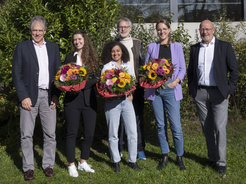Three early-stage researchers receive Young Scientist Award
Sandra Reinert, Renée Vieira and Sandra Fendl recognized for outstanding publications
Three female scientists at the Max Planck Institute for Biological Intelligence (in foundation) have received the Young Scientist Award. It goes to Sandra Reinert for her research on learning processes in mice, and jointly to Renée Vieira and Sandra Fendl for developing a new method to study nerve cell proteins in fruit flies. The Young Scientist Award is endowed with 1000 € and recognizes the outstanding publications that resulted from this research.

How does the brain simplify complex information?
Categorization is an important element of our thinking. The brain uses it to organize and simplify the myriad impressions of our daily lives. This enables us to react quickly and effectively to new experiences. Categorization is based on a complex learning process that is still only partially understood. Sandra Reinert and her colleagues in Tobias Bonhoeffer's department are investigating the process of category learning in mice. Their work has shown that mice can categorize surprisingly well. To do this, the brain uses specific groups of neurons that represent learned categories and store them as abstract information. The research paper, which was now recognized with the Young Scientist Award, was published in the journal Nature in April 2021.
Sandra Reinert studied biology at Ludwig-Maximilians-Universität München and completed her doctoral thesis in the department of Tobias Bonhoeffer, where she is now a postdoctoral researcher.
How do nerve cells exchange information?
An important part of the communication between nerve cells takes place via receptor proteins. The proteins are located in the membrane surrounding the cells, where they pick up incoming signals from other cells and pass them on to “their” cell. Depending on type and position, the receptors determine how nerve cells respond to incoming information. Thus, to understand the functioning of a neuronal network, it is essential to know which receptors are present and where they are located. Renée Vieira and Sandra Fendl in Alexander Borst's department developed a new method that allows scientists to study nerve cell receptors. The method visualizes with high accuracy the position of receptor proteins on the cell surface. The method can also be used for other proteins and thus represents a new universal tool for protein research in the fruit fly.
Renée Vieira studied biology at McMaster University in Hamilton (Canada) and at Ludwig-Maximilians-Universität München. She is currently a PhD student in the department of Alexander Borst.
Sandra Fendl studied biology at Universität Regensburg and at Ludwig-Maximilians-Universität München, and completed her PhD in the department of Alexander Borst. She is now a scientific officer at acatech - Deutsche Akademie der Technikwissenschaften e.V..














